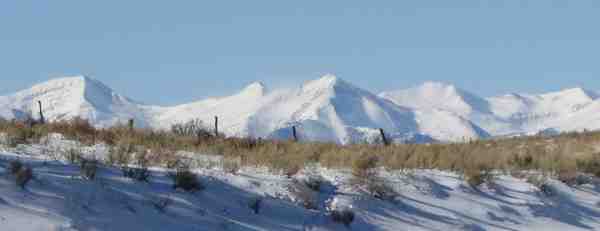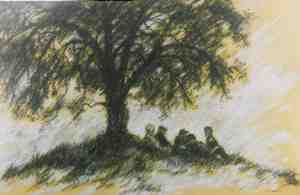Column by Hal Walter
Climate – February 2008 – Colorado Central Magazine
AFTER AN EXTENDED, warmer-than-usual fall, cold weather struck the Wet Mountains with a vengeance in mid-December. By the time the holidays rolled around, Heaven had indeed frozen over with nighttime temperatures regularly dropping below zero and hovering in the low single digits on the warmer nights.
This sort of thing tends to get the attention of someone who cares for livestock. For starters, you have sympathy for animals that live outdoors under these conditions. For another, anything you have to do to care for these animals is more difficult in extreme cold weather.
As the years pass, I’m finding my tolerance for cold weather is fading, and I’m beginning to wonder if the intellectual stimulation that I truly believe can be found in manual, outdoor work is purely fantasy. The chill of single-digit and below temperatures hurts me deep in my bones, not to mention my brain. Like a smart donkey, some mornings I find myself doing breakfast dishes, starting a load of laundry and even vacuuming as avoidance behavior before pulling the Carhartts over layers of other clothes and heading out to do chores.
This winter I am caring for ten horses at the ranch I manage, along with a bull and heifer in our leased pasture. I also have five burros at my place.
The bull is staying for the winter because he is not welcome at the ranch in Avondale where we board the rest of our cattle for the winter. He was a new addition to the herd this past summer. The heifer is what is called a Free Martin. In cattle terms this means she is the female twin to a bull calf, and most likely barren. Since she’s probably not pregnant, we decided to leave her with the bull to keep him company until the cows return in the spring.
I’m feeding these two bovines at the corral in the summer pasture. They don’t wander far from there because of the snow and ice. There’s a small spring-fed creek just below the corral, and I’ve been breaking ice on it now for 42 straight days.

At first it was pretty easy to keep 25 feet of the stream open each morning with a shovel. As the nights got colder I turned to a sledge-ax and then used the shovel to spoon out the broken ice and slush. Once broken, the stream runs all day until the frigid nighttime temperatures solidify it again.
There is a certain spot that seems to bubble up naturally. I normally start there and work my way downstream. Some mornings there is a little water gurgling under the ice. Other mornings there is nothing moving until the maul strikes home and then the beautiful crystal-clear water bubbles up and collects in the basin that I pound out of the ice downstream. Pieces of bright-green duckweed and watercress sometimes swirl around in the water, strangely foreign in a world of ice and snow.
Oddly, the thickness of the morning ice does not necessarily correlate with how cold it was the previous night. Some mornings after it’s been very cold there may be a small amount of water running. But following some relatively warm nights (I think we had one heat wave when the low temperature may have been in the teens) the water may be completely seized up. I found this phenomenon perplexing until I realized what I am probably dealing with is a lag-time effect of nighttime temperatures on water upstream on this miniature glacier. Perhaps if the water is running it may be because it was warmer a few nights ago. Or vice-versa.
Whatever the case, the bull and heifer seem glad to have the fresh water to go along with their daily ration of hay, and often watch me with sincere interest as I go to and fro with the shovel and ax. People think cattle are dumb but I believe they are at least as smart as most horses and quite obviously smarter than many people as frequently evidenced by the voting public.
FOR THE HORSES at the ranch I have three separate troughs with electric stock tank heaters. Horses drink six to ten gallons daily in winter, so usually I need to fill each of these tanks with a hose every day. If I wait two days, the water level can get dangerously low in relationship to the heating element, and the bigger tanks take way too much time to fill.
Early on, I could disconnect the hose, tie one end of it to a hitching post near the hydrant and pull the other end downhill to drain. However, when the severely cold weather set in, the hose started freezing despite draining. Then the hydrant itself froze. I was truly hosed. I wrapped the hydrant pipe in electrical tape and thawed the hose out in my truck with the heater running flat out. Afterward, I decided to hang the hose from a tree branch to get a steeper angle for quicker, more thorough draining.
While tank heaters generally make things easier, I had a bit of an adventure with one that was behaving erratically this winter. Some days the tank would be clear and other days I had to break ice. The heaters screw into the bottoms of the tanks and are plugged into ground-fault interruption receptacles for safety. I noticed if I hit the reset button the heater would sometimes, but not always, start working again.
This left me wondering if the problem was with the heater or the GFI box. Though I suspected the heater, one evening I dumped the tank and pulled it around the corner to another GFI, plugged it in, and began filling it with water. I was startled by a loud pop and an eruption of sparks when the water hit the short-circuited heater in the tank. I jumped and sprinted about 20 feet and when I turned around there was a small cloud of smoke and a burned electrical smell on the air. Clearly I had to get a new tank heater, but for an instant the need for clean underwear was also in question.
Getting hay to the animals is another task not made easier by the cold. I feed the horses with 1,100-pound round bales that I move with a tractor. The thing is, this tractor might be older than I am and is also a two-wheel drive. Getting the tractor started on a cold morning is a strange form of witchcraft involving a plug-in heater, spray-can ether and very precise choke and throttle settings. Getting this machine to the hay in sugar snow is another challenge, even with tire chains. It hasn’t been a picnic, but thus far the horses have not gone hungry.
For the two cattle, I’ve been buying baled hay from the Schneider Ranch south of Westcliffe, where Phil and Paul have been kind enough to keep me supplied. Thus far I’ve made four runs for pickup loads of this hay, twice on evil icy roads. Cow hay doesn’t need to be barn-stored like horse hay, so I just stack it outdoors near the corral. I have encountered some bales so ice-covered that I had major trouble removing the twine.
I find a certain irony that in the age of global warming I am freezing my ass off. There’s been a debate both nationally and even locally in the Wet Mountain Tribune about whether global warming is for real. One letter-writer even used local historic temperatures as laughable substantiation for his argument that global warming is not a serious issue. In reality, I think most scientists agree that the melting of the polar ice caps, not to mention chemical and temperature changes in ocean water, indicates something is up with climate change. It’s absurd to think that man’s activities — particularly the overuse of fossil fuels — have not had at least some effect in all of this.
Regionally we are starting to see some effort to reverse this problem. SunEdison recently went online with an 8.22-megawatt solar power plant on 80 acres in the San Luis Valley. The photovoltaic plant is expected to generate enough electricity to power 1,500 homes.
Though this is not a lot of electricity in the big scheme of things, the opening of this plant represents a positive step toward renewable and clean energy sources, as well as homegrown economic opportunity. If we had 160 acres of photovoltaics in Custer County — just one 40-acre lot on four of the larger subdivisions — we could generate enough power for every home in this county.
It makes no sense from an environmental, economic, or national security standpoint to not begin reducing our use of fossil fuels, especially foreign oil. Even those with the poorly grounded view that manmade climate change is some sort of liberal Hollywood “fantasy” should be able to understand the benefits of moving toward cleaner, renewable energy sources.
One very cold morning with a below-zero wind chill and a dry snow stinging my face, the cattle followed me down to the creek and stood nearby as I chopped the ice. As soon as the water was flowing the Free Martin crowded me out. I stood back and watched with my hands in my armpits as the bull waited for the heifer to drink and then took his turn sipping from the slushy water. This is no country for man nor beast in the wintertime.
Hal Walter breaks ice in the Wet Mountains of Colorado.


